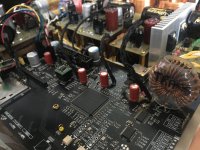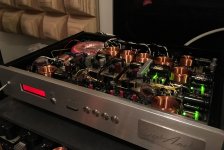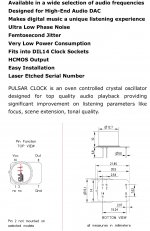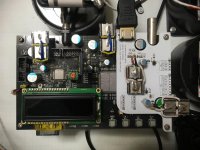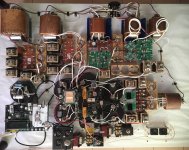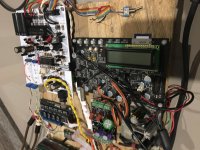Hello
The SDtrans384 player has been one of the best sounding digital player I have owned so far.
I have spent over 6 months on it and just completed the mod with better chassis and with all discrete linear power supplies.
Totally 9 sets of PSU supplying the SD card, FPGA chips, clocks and display + remote module
Onboard filter caps changed to Blackgate NX
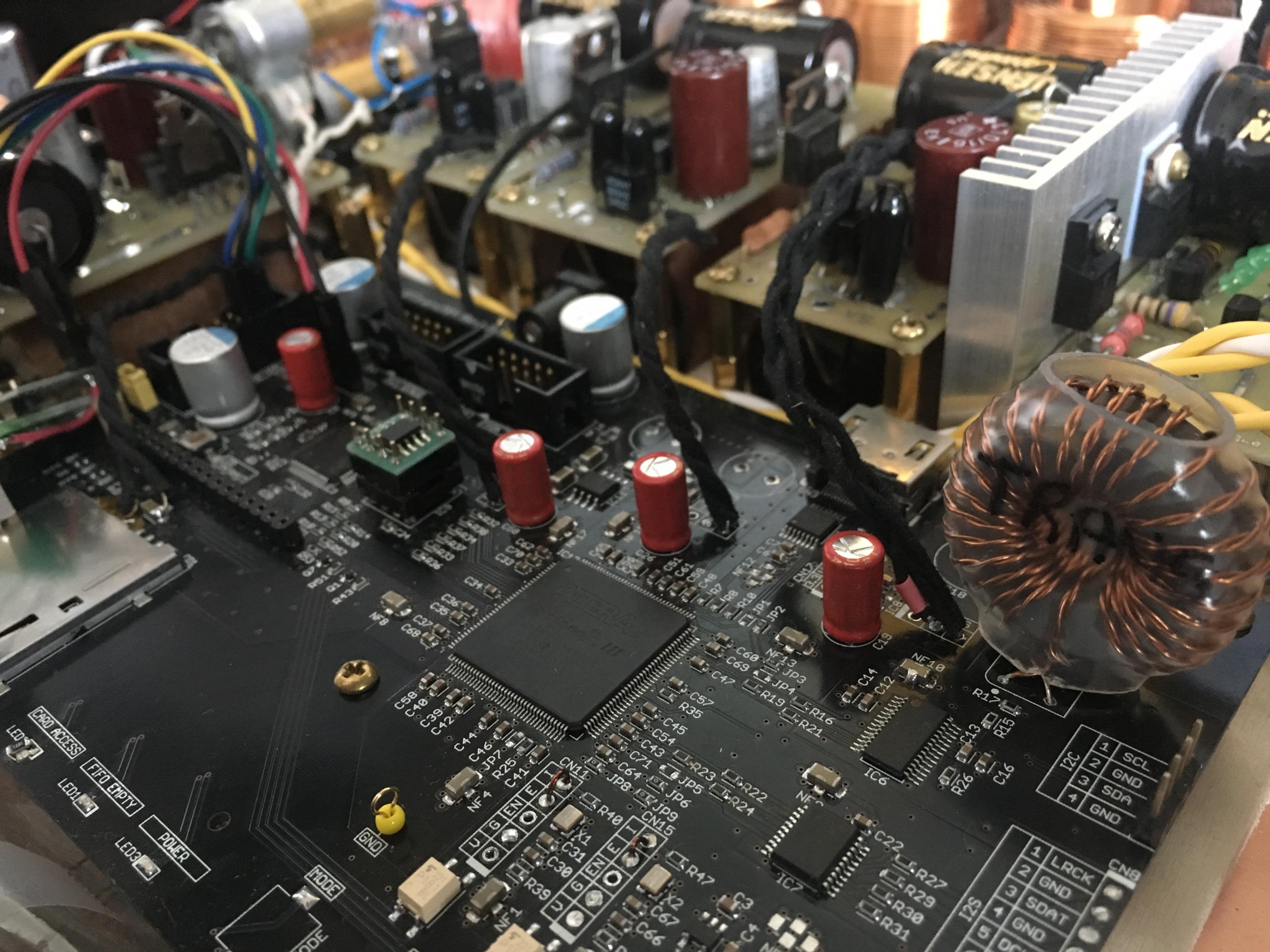
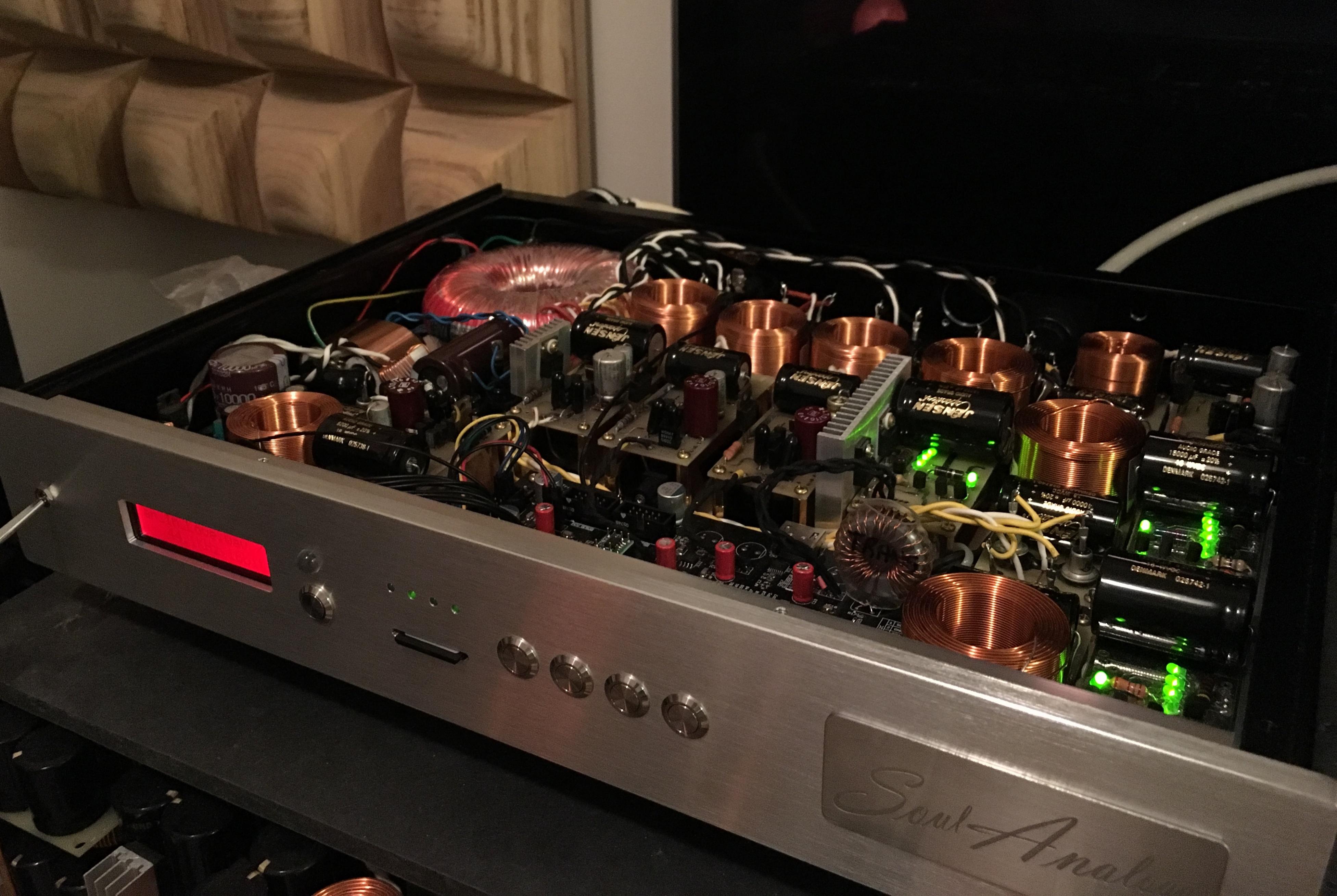
Question: is there anybody successfully changed the clocks with better ones? I mean with auto select of clock signal according to the bit rate of the music files...
Thanks!
The SDtrans384 player has been one of the best sounding digital player I have owned so far.
I have spent over 6 months on it and just completed the mod with better chassis and with all discrete linear power supplies.
Totally 9 sets of PSU supplying the SD card, FPGA chips, clocks and display + remote module
Onboard filter caps changed to Blackgate NX
Question: is there anybody successfully changed the clocks with better ones? I mean with auto select of clock signal according to the bit rate of the music files...
Thanks!
Attachments
I appreciate your awesome approach very much! Chiaki and I are very proud to have such an enthusiastic user of SDTrans384.
In Japan, there is two users those who tried upgrade of Clocks. Both connected external clocks, Pulsar OCXO as well as NDK DuCULoN OCXO. I’m not sure Pulsar is still available in a market. Pulsar will provide better SQ and DuCULoN will do far better. However, your selection may depend on your DIY policy and budget plan.
Apart from a clock upgrade, I’d like to recommend also a decoupling capacitor addition to DC power lines. In the next post, I will report my trials.
In Japan, there is two users those who tried upgrade of Clocks. Both connected external clocks, Pulsar OCXO as well as NDK DuCULoN OCXO. I’m not sure Pulsar is still available in a market. Pulsar will provide better SQ and DuCULoN will do far better. However, your selection may depend on your DIY policy and budget plan.
Apart from a clock upgrade, I’d like to recommend also a decoupling capacitor addition to DC power lines. In the next post, I will report my trials.
Wow very nice mega work involved. I too have done a fair bit of mods to mine but I've
taken a slightly different approach. Yes I'm running independent discrete regulators too.
On SdTrans just using stock caps with Sun copper bypass caps. What I found affects sound most is at the psu of the discrete regs, real surprise here. For me I've tweaked the SdTrans to work in sync with my AyA DS dac cause I'm running I2S connection. AyA too has been highly tweaked. Still in bare bones plywood mount but looking for a nice box to install.
Congrats
taken a slightly different approach. Yes I'm running independent discrete regulators too.
On SdTrans just using stock caps with Sun copper bypass caps. What I found affects sound most is at the psu of the discrete regs, real surprise here. For me I've tweaked the SdTrans to work in sync with my AyA DS dac cause I'm running I2S connection. AyA too has been highly tweaked. Still in bare bones plywood mount but looking for a nice box to install.
Congrats
I appreciate your awesome approach very much! Chiaki and I are very proud to have such an enthusiastic user of SDTrans384.
In Japan, there is two users those who tried upgrade of Clocks. Both connected external clocks, Pulsar OCXO as well as NDK DuCULoN OCXO. I’m not sure Pulsar is still available in a market. Pulsar will provide better SQ and DuCULoN will do far better. However, your selection may depend on your DIY policy and budget plan.
Apart from a clock upgrade, I’d like to recommend also a decoupling capacitor addition to DC power lines. In the next post, I will report my trials.
Hi Bunpei,
So glad to hear your feedback!
I can get the pulsar...from their official website...but I have no clue how to get the DuCULoN
But anyway the biggest technical difficulty is to let SDtrans to auto select which clock crystal to use, if the OCXO has no EN/SB pin...
Btw the SdTrans is really really good but one will not hear it's full potential until you use the dedicated output & not use the spidf at all.
Cheers
I myself is using the i2s output of SDtrans384 all the way...directly coupled to DAC chip
I mod the output digital transfo is for the cases that I bring the machine to my fd's place demonstration when they have no i2s input dac
Last edited:
Nice so are you into TDA dac as well ?
Yes
I will create a thread for my dac later
But anyway the biggest technical difficulty is to let SDtrans to auto select which clock crystal to use, if the OCXO has no EN/SB pin...
Pulsar OCXO has an enable/disable pin. You can use it.
NDK DuCULoN bipolar output type has no corresponding function. In my case, a socket is employed for DuCULoN and two DuCULoN units are manually changed.
Adopting a mechanical relay might be one alternative good way.
http://omronfs.omron.com/en_US/ecb/products/pdf/en-g6k_2f_rf.pdf
Pulsar OCXO has an enable/disable pin. You can use it.
Checking from the pulsar ocxo datasheet, i still cannot figure out how to enable/disable the ocxo by its pins
Please shed some light ....

Attachments
but I have no clue how to get the DuCULoN.
You can get a quote from “Chip1Stop” web shop.
NH47M47LA-45.1584M-NSA3647I Series nameSeries Nihon Dempa Kogyo (NDK) | Timing device | Oven-controlled crystal oscillator (OCXO) - chip1stop.com
However, Their list price might be 1,800 USD/each or higher.
You can get a quote from “Chip1Stop” web shop.
NH47M47LA-45.1584M-NSA3647I Series nameSeries Nihon Dempa Kogyo (NDK) | Timing device | Oven-controlled crystal oscillator (OCXO) - chip1stop.com
However, Their list price might be 1,800 USD/each or higher.
oh..the price is too steep...
I thought the pulsar is expensive enough....
In such case I would like to try Pulsar OCXO first...
Just still not sure about the EN/SB pin on Pulsar
My best mod recommendation is adding this capacitor, NEC/Tokin Proadlizer, to an existing Aluminum Electrolytic Capacitor on board in parallel.
https://www.nec.com/en/global/techrep/journal/g06/n05/pdf/t060514.pdf
The product, Proadlizer, was originally developed and applied as a decoupling capacitor for CPU in a notebook computer. However, they had a quality problem on Toshiba DynaBook and discontinued the product. Some stock pieces can be available in eBay.
Type number, “0E128”, is 2.5V 1200uF. No higher voltage type is available. In my case, I put two pieces in serial when I apply them to DC +3.3V or +5.0V power line.
A typical price in eBay is 5-6 USD/each. Once you experience its effectiveness, you may think that price is reasonable.
The capacitor has a size of typical post stamp.
Attached photo shows my application as an example.
https://www.nec.com/en/global/techrep/journal/g06/n05/pdf/t060514.pdf
The product, Proadlizer, was originally developed and applied as a decoupling capacitor for CPU in a notebook computer. However, they had a quality problem on Toshiba DynaBook and discontinued the product. Some stock pieces can be available in eBay.
Type number, “0E128”, is 2.5V 1200uF. No higher voltage type is available. In my case, I put two pieces in serial when I apply them to DC +3.3V or +5.0V power line.
A typical price in eBay is 5-6 USD/each. Once you experience its effectiveness, you may think that price is reasonable.
The capacitor has a size of typical post stamp.
Attached photo shows my application as an example.
Attachments
Hi Bunpei,
You mind sharing your findings about the Toshin PPSD caps ?
I've actually tested it in a few places including analog stage & frankly
its not all that fantastic. Sound wise yes pleasant but it's a little slow
especially on analog application. Has similar kind of presentation to
nichicon kg.
Thks
You mind sharing your findings about the Toshin PPSD caps ?
I've actually tested it in a few places including analog stage & frankly
its not all that fantastic. Sound wise yes pleasant but it's a little slow
especially on analog application. Has similar kind of presentation to
nichicon kg.
Thks
My system is shown on the attached photo. I had been very busy for enhancing PSUs for my DAC part until recent times.
For my SDTrans384 part, I provide two DC +5V power lines. One for main and another for LCD back light.
From now on, I think I can concentrate on PSU for SDTrans384 part.
For my SDTrans384 part, I provide two DC +5V power lines. One for main and another for LCD back light.
From now on, I think I can concentrate on PSU for SDTrans384 part.
Attachments
Thanks again Bunpei. Like you I’ve been tweaking my how set up from speakers, amp, dac & Sdtrans. What I have discovered is no matter how quiet your regulators are, nothing is as important as the main psu caps. What brand, values & bypass, greatly affects the sound. My last tweak was focus on SdTrans cause my original thoughts was since Im already supplying very low noise discrete regs, sound should be great but when I started to play with PS caps, omg how could it be, the sound improve vastly, I was really really surprise that this could happen on digital side. Moral of story, just because you’ve got low noise regs it doesn’t mean that mains noise will not break through. Oh another thing the 2.5 & 1.2 v are highly sensitive I use higher uf value PS caps on 1.2 over the 2.5v
Cheers
Cheers
Checking from the pulsar ocxo datasheet, i still cannot figure out how to enable/disable the ocxo by its pins
Please shed some light ....
Hi, insatiable!
I’m very sorry that I left your question unreplied!
My memory was incorrect and you are right. According to the data sheet, Pulsar OCXO has no output control pin.
I think the best way is to incorporate a mechanical relay designed for high frequency applications.
Bunpei
- Status
- This old topic is closed. If you want to reopen this topic, contact a moderator using the "Report Post" button.
- Home
- Source & Line
- Digital Source
- SDTrans384 mod discussion thread
